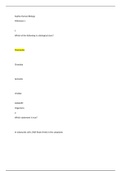Samenvatting
Extensive summary of The Psychology of Influence Pligt & Vliek - The Psychology of Media and Communication (6464EC03Y_2324_S1)
- Instelling
- Universiteit Leiden (UL)
This document includes an extensive summary of all the book chapter from the book the psychology of influence by van der Pligt and Vliek for the course Psychology of Media and Communication.
[Meer zien]














